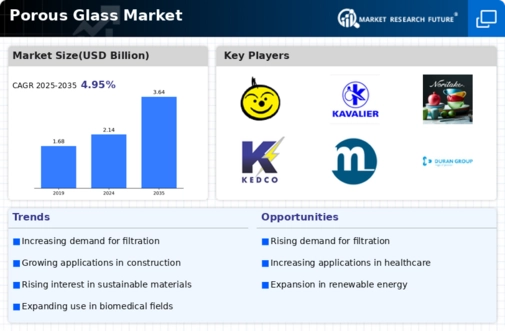Market Growth Projections
The Global Porous Glass Market Industry is poised for substantial growth, with projections indicating a market value of 2.14 USD Billion in 2024 and an anticipated increase to 3.64 USD Billion by 2035. This growth trajectory suggests a compound annual growth rate (CAGR) of 4.95% from 2025 to 2035. Such metrics highlight the increasing adoption of porous glass across various sectors, driven by its unique properties and versatility. The market's expansion is likely to be influenced by factors such as technological advancements, rising environmental concerns, and the growing demand for sustainable materials.
Growing Environmental Concerns
Environmental sustainability is becoming a critical driver for the Global Porous Glass Market Industry. The material is increasingly favored for its eco-friendly properties, as it can be produced from recycled glass and is fully recyclable itself. Industries are under pressure to adopt greener alternatives, and porous glass offers a viable solution for applications in construction, packaging, and filtration. The shift towards sustainable materials is likely to enhance the market's appeal, as businesses and consumers alike prioritize environmentally responsible choices. This growing emphasis on sustainability is expected to bolster market growth, contributing to the overall increase in demand for porous glass products.
Advancements in Material Science
Innovations in material science are propelling the Global Porous Glass Market Industry forward. Researchers are developing new formulations and manufacturing techniques that enhance the properties of porous glass, such as increased porosity and improved mechanical strength. These advancements enable the material to be used in a wider array of applications, including filtration systems and insulation materials. As industries seek more efficient and sustainable solutions, the demand for advanced porous glass products is likely to rise. This trend aligns with the projected market growth, which is anticipated to reach 3.64 USD Billion by 2035, indicating a robust CAGR of 4.95% from 2025 to 2035.
Emerging Markets and Globalization
Emerging markets are playing a pivotal role in the Global Porous Glass Market Industry, as globalization facilitates the exchange of technology and materials across borders. Countries in Asia-Pacific and Latin America are witnessing increased industrialization, leading to a higher demand for porous glass in various applications, including filtration and insulation. The growth of these markets is supported by investments in infrastructure and manufacturing, which are likely to drive the consumption of porous glass products. As these regions continue to develop, they present significant opportunities for market expansion, contributing to the overall growth trajectory of the porous glass industry.
Expansion in the Construction Sector
The construction industry is a significant contributor to the Global Porous Glass Market Industry, as porous glass is utilized in various applications such as insulation and decorative elements. Its lightweight nature and thermal properties make it an attractive option for modern construction projects, particularly in energy-efficient buildings. As urbanization continues to rise globally, the demand for innovative building materials is likely to increase. This trend is supported by government initiatives promoting sustainable construction practices, which further enhances the market's potential. The construction sector's expansion is expected to play a crucial role in driving the growth of the porous glass market in the coming years.
Rising Demand in Healthcare Applications
The Global Porous Glass Market Industry is experiencing a notable surge in demand driven by its applications in the healthcare sector. Porous glass is increasingly utilized in drug delivery systems and tissue engineering due to its biocompatibility and ability to facilitate controlled release of pharmaceuticals. For instance, the material's unique properties allow for the development of scaffolds that support cell growth, which is crucial in regenerative medicine. This trend is expected to contribute significantly to the market's growth, with projections indicating a market value of 2.14 USD Billion in 2024, reflecting the increasing integration of porous glass in medical technologies.




















